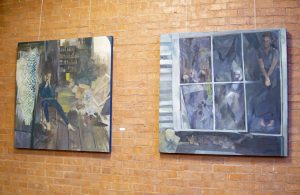Portraits and still-life paintings line the walls of a spacious room in the Sally McDonnell Barksdale Honors College, each one presenting a deeper, more intimate look into a moment suspended in time. Curated by Honors College Artist-in-Residence Bruce Levingston, 2018 Ole Miss graduate and current visiting assistant professor Brooke P. Alexander’s exhibition “Always Already There” is now hanging in the Honors College’s Great Room.

“The blurry, the dark, shadowed places hidden and dwelling amongst the certainty steal my attention,” writes Alexander in her personal statement, which hangs alongside her work. “Such spaces can communicate a vast sense of both time and place, that which is both occurring and that which is past.”
The subjects of these paintings come in and out of focus to a viewer. Inanimate objects and shadows draw the eyes to search every corner before finally examining the subject of the portrait.
There is an uncertainty to the details of background and foreground — leaving the lives of the subjects a blur. The colors of the paintings are particularly striking. The muted, dark tones Alexander chooses prove a stark contrast to the red brick walls of the room.
“These paintings are focused on ambiguous spaces,” Alexander said in an interview. “They contain muted colors and chromatic grays that reflect those ambiguous spaces. I draw a lot of inspiration from the painter Edwin Dickinson who uses muted, subdued colors.”
Alexander’s use of subdued colors juxtaposes with the gentle emergence of softer, brighter colors and motifs of flowers — often in a state of decay.
The namesake piece of the exhibit, “Always Already There,” presents a black silhouette of roses behind the panes of glass of a window. Other pieces, like “Patterned Wallpaper” and “Blue,” include vibrant bouquets of flowers but give way to the true focal point of each of Alexander’s portraits: the subjects, the people themselves.

Photo by Jade Richardson
The subjects of these portraits are infused with mystery. Ambivalent expressions push viewers to look closer and stare longer and to ponder what goes on in the subjects’ minds.
“This exhibition is a grouping of paintings that concern the connection between interior spaces and the people in them,” Alexander said. “They are reflections and explorations of the figures’ minds.”
However, the pieces included in “Always Already There” contain much more than the physical features of people. They include details of the inanimate objects that surround our private spaces — shelves, littered floors, kitchen tables, a recently blown-out candle, window panes. These elements heighten the mystery and privacy each subject maintains.
“The paintings that compose this show communicate a space that is not readily understood. They are places that embody a simultaneous presence and absence, an impression,” Alexander said.
Viewers will be delighted and confounded by the menagerie of details present in Alexander’s works. These paintings are not easily understood, but there is a strain of something familiar and a spark to keep examining, to better understand the the private worlds the subjects live in.






